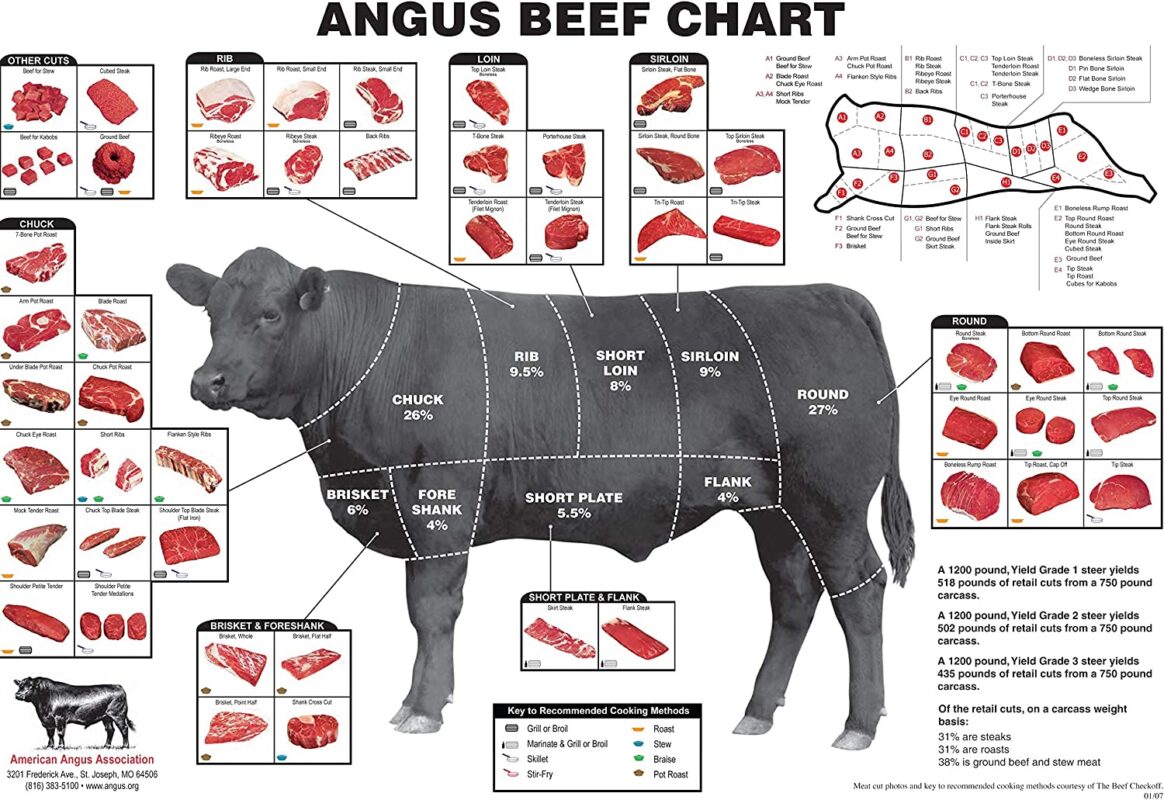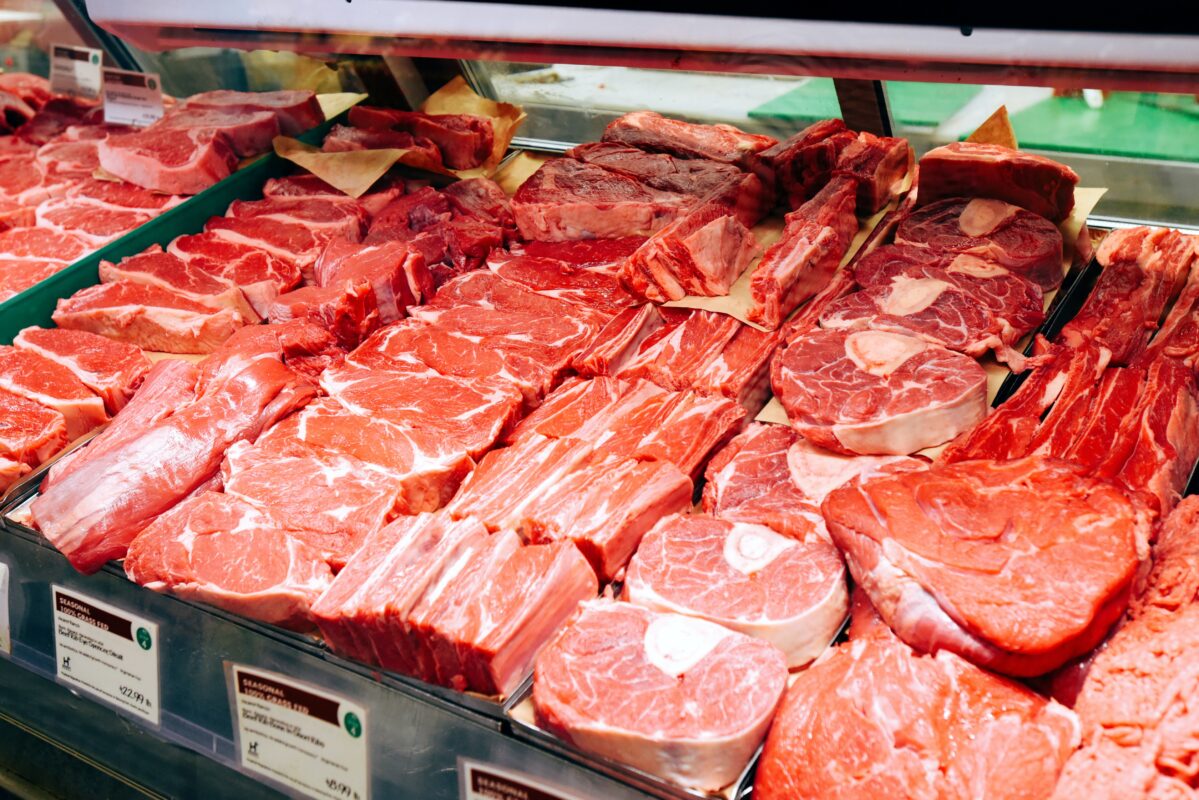Angus Beef Cuts Chart
Meat Cuts Illustrating the Various Cuts of Beef from a Black Angus

There are eight main cuts of beef which are known as the primal cuts, listed below:
- Chuck
- Rib
- Loin
- Round
- Flank
- Short Plate
- Brisket
- Shank
These large primal cuts are then divided into smaller sub-primal cuts that are shipped by packers to local markets for final cutting and preparation. These final cuts are known as portion cuts, and are the cuts of meat that consumers will find in their local stores like steaks, ribs and roasts.
Chuck
Chuck comes from the cow’s shoulder. It’s a very flavorful region that can be cut and prepared in many ways, but it’s also typically a firmer, tougher cut of beef. Chuck tends to be a lesser expensive cut of meat.
The types of portion cuts you can find for chuck are ground chuck (hamburgers), chuck short ribs, shoulder tender medallions, chuck pot roast, shoulder steak, flat-iron steak and stew meat, amongst others.
Rib
As the name implies, the rib primal cut refers to meat cut from the cow’s ribs and backbone. Of the 13 pairs of ribs on a cow, only the last six are classified in this section – the rest are grouped with chuck and short plate! Rib cuts are notable for their fatty marbling, tenderness, and distinctive flavor. Rib cuts tend to be a little pricier than most and are often better slow-cooked than grilled.
The types of portion cuts you can find for ribs are beef short ribs, ribeye steak, cowboy steak, ribeye roast, ribeye filet and back ribs.
Loin
This is where you’ll find your most expensive cuts of beef. The loin is located directly behind the ribs and, due to its location, is not a heavily used muscle. This makes loin very tender compared to more muscular cuts. The loin primal cut comprises two parts worth mentioning: sirloin and short loin.
Sirloin is the rearmost cut of the loin region and the least tender of the two sub-regions (though these cuts are more flavorful). Sirloin is typically best for grilling and almost never used for slow cooking. Common cuts include sirloin steak, top sirloin, bottom sirloin, tri-tip roast and tri-tip steak.
Short loin is similar to sirloin cuts, but is closer to the center of the cow and more tender than sirloin cuts as a result. Like sirloin, it dries out very fast so it’s typically best grilled or fried. Common short loin cuts include NY strip, the T-Bone, porterhouse, tenderloin filet, delicious filet mignon and strip loin.
Round
The round primal region is an inexpensive, lean cut. Located near the cow’s hind legs, it’s typically a tough cut of beef. Due to the leanness of this cut, it’s important to thoroughly research how to prepare and cook the individual portion cuts of this primal region; sometimes it calls for high heat cooking (like top, bottom and eye round portion cuts), or slow-cooking (like rump and eye roast).
The common round cuts you can find in stores are round steak, eye of round, tip roast, tip steak, top round and bottom round roasts.
Flank
The flank primal cut is located just below the loin. This region has no bones, but is flavorful despite its toughness. In the past, it was typically the least expensive cut one could find in a store. However, as the recent demand for lean meat increased, so did the demand for flank steak – driving its popularity as well as the price up.
Typically you’ll only find one of two flank cuts: a flank steak or a skirt steak, both of which are best grilled at high heat.
Short Plate
Often grouped with the brisket beef region, short plate cuts are found near the stomach of the cow. Its location in the cow lends to cheap, tough and fatty cuts of beef. This is also where you’ll find your other source of marbled short ribs.
The most common short plate portion cuts you can expect to find in stores are skirt steak, hanger steak, beef bacon, pastrami, short ribs and ground beef from this primal cut.
Brisket
A barbecue favorite, the brisket cut comes from a cow’s breast. Brisket is known for its fatty, tough texture, but if prepared correctly (low and slow) it can be cooked to melt-in-your-mouth perfection. Just be careful when slow cooking – with brisket, there’s a slim margin between juicy and dry! You should always tenderize as well as marinate this cut before slow cooking to soften it up.
There’s typically only two cuts of brisket you’ll find widely available: brisket point and brisket flat. They are both better slow-cooked, but the flat is distinguished by its leaner quality.
Shank
Shank is arguably the toughest, cheapest cut of beef. The shank is located in front of the brisket at the cow’s forearm, this beef cut is notable for its sinewy dryness. Due to its lack of popularity, shank is not typically found in retail stores. However, if you can find it, it’s a great inexpensive option for beef stock or lean ground beef. Due to its dry nature, it’s best cooked for a long time in moist heat.
